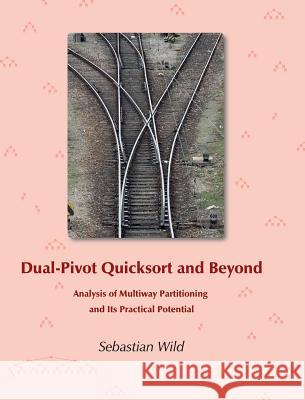Dual-Pivot Quicksort and Beyond: Analysis of Multiway Partitioning and Its Practical Potential » książka
Dual-Pivot Quicksort and Beyond: Analysis of Multiway Partitioning and Its Practical Potential
ISBN-13: 9783000546693 / Angielski / Twarda / 2016 / 382 str.
Dual-Pivot Quicksort and Beyond: Analysis of Multiway Partitioning and Its Practical Potential
ISBN-13: 9783000546693 / Angielski / Twarda / 2016 / 382 str.
(netto: 203,28 VAT: 5%)
Najniższa cena z 30 dni: 213,44
ok. 16-18 dni roboczych
Bez gwarancji dostawy przed świętami
Darmowa dostawa!
"This is without question the best PhD thesis that I have read since the 1970s.
Its coverage is breathtaking." Robert Sedgewick Quicksort is the fastest general-purpose sorting method in practice and a showcase for the paradigms of the mathematical analysis of algorithms: it can occasionally be very slow, but is almost always extremely fast, and its typical performance can be computed very accurately in
a mathematical model. It is a distinctive feature of computer science that such mathematical models describe many phenomena precisely because we know how our computers work. But we need an effective mathematical toolkit to put this to good use. The author analyzes mathematically what benefits are possible with multiway Quicksort, i.e., partitioning the input in one step around several pivots. Multiway Quicksort has recently received attention because Java runtime library uses a dual-pivot method that outperforms classic Quicksort implementations by far. The success of dual-pivot Quicksort is most likely due to more efficient usage of the memory hierarchy, which gives reason to believe that further improvements are possible with multiway Quicksort. Apart from presenting novel facts on Quicksort, including results on inputs with equal keys, this books also serves as compendium of mathematical techniques for the analysis of Quicksort. It is the only comprehensive resource on developments in the field since Robert Sedgewick's dissertation from 1975.
“This is without question the best PhD thesis that I have read since the 1970s.
Its coverage is breathtaking.” Robert SedgewickQuicksort is the fastest general-purpose sorting method in practice and a showcase for the paradigms of the mathematical analysis of algorithms: it can occasionally be very slow, but is almost always extremely fast, and its typical performance can be computed very accurately in
a mathematical model. It is a distinctive feature of computer science that such mathematical models describe many phenomena precisely because we know how our computers work. But we need an effective mathematical toolkit to put this to good use.The author analyzes mathematically what benefits are possible with multiway Quicksort, i.e., partitioning the input in one step around several pivots. Multiway Quicksort has recently received attention because Java runtime library uses a dual-pivot method that outperforms classic Quicksort implementations by far. The success of dual-pivot Quicksort is most likely due to more efficient usage of the memory hierarchy, which gives reason to believe that further improvements are possible with multiway Quicksort.Apart from presenting novel facts on Quicksort, including results on inputs with equal keys, this books also serves as compendium of mathematical techniques for the analysis of Quicksort. It is the only comprehensive resource on developments in the field since Robert Sedgewick's dissertation from 1975.











